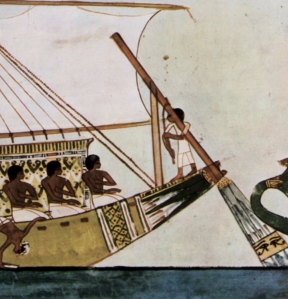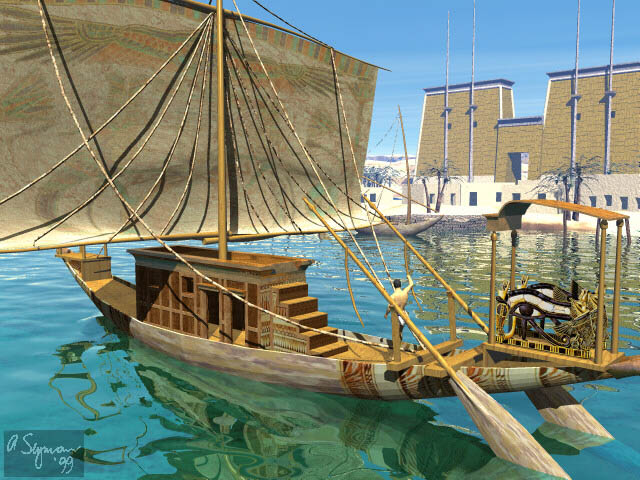Previously, we talked about how we might experience Isis’ response to us when we ask for Her presence through our invocations, meditations, or other rites. This time, let’s look at one of the (many) reasons we might request Her presence: to ask for Her guidance in some aspect of our lives.
Divine guidance and assistance are among the most common reasons we seek out contact with our Deities. Naturally, this applies to Isis devotees as well. Indeed, Her people have always come to Her for such guidance. When seeking such guidance, one of the ways we could do this would be to employ a symbol of the aid we’re requesting. In this case, we might use one of Her important, but more obscure, symbols that is emblematic of Her guidance in our lives. It is the rudder.
Unless you are someone who spends a lot of time on the water, you might not be very familiar with the vital importance of rudders. Not so with the ancient Egyptians. As a river-dependent civilization, ancient Egypt was quite familiar with the rudders used to steer boats. It is perhaps no great leap to see the guiding rudder as a symbol of the greater guidance of the Divine.
Just as Egyptian pilots steered their earthly boats with these rudders, so they became a symbol of guidance and direction in the afterlife. And so may we also take them as a symbol of guidance in our spiritual lives as well as our everyday lives.
In the Book of Coming Forth by Day, for example, the deceased prays that Horus, the son of Isis, will be in charge of the rudder of his funerary boat and that Thoth and Ma’et will be beside Him. In other words, he prays to be guided by the strength of Horus and the wisdom of Thoth and Ma’et.
When depicted in the funerary books, these Divine steering-oars are often decorated with the Eyes of Horus, representing the power of the Sun and Moon, and the blue lotuses of rebirth. In a group of four, the oars represent the four cardinal directions.
The rudder is also connected with the concept of abundance. In the Book of Coming Forth by Day, the deceased prays to the living Rudders of the four directions asking them to grant bread, beer, offerings, provisions, long life, prosperity, health, and joy. Furthermore, directly following this prayer to the Rudders is the formula of the Divine Cows and Their Bull. It, too, has to do with provisions in the afterlife, as well as rebirth from the Divine Cow. The proximity of the formulae of the Divine Rudders and the Divine Bovines, as well as their similar subject matter, indicates a relationship between them. Not only do both have to do with abundance and life, but also, like the four Rudders, the four legs of the Divine Cow we sometimes associated with the four directions.

Both cow and rudder are, in turn, related to Isis. She is the Divine Cow Who gives abundance and rebirth and She is also a Goddess Who guides. In Egyptian texts, Isis is one of the Deities Who guides the Sun God’s boat. In later Graeco-Roman sources, Isis is specifically connected with the symbol of the guiding rudder. As Isis Pelagia, Isis of the Sea, the Goddess was known to steer the ship of life with Her sacred rudder. Mariners of all kinds invoked Her guidance and protection as they crossed the Mediterranean, braving its many dangers.
In the Mediterranean world, the symbolism of the rudder continued to embrace the ideas of abundance and prosperity. In Hellenic lands, the rudder was a symbol of Agathe Tyche (“Good Fortune”). In Rome, it was the emblem of the Goddess Fortuna—and both Goddesses were intimately connected with Isis. In fact, of all the Goddesses in the areas influenced by Greece and Rome, Isis was the one Deity with Whom Agathe Tyche and Fortuna were most consistently assimilated.
As Agathe Tyche, Isis was considered the “luck” of a number of port cities, particularly Alexandria. In fact, Her headdress emphasizes her connection with cities. As guardian of cities, Tyche wears an elaborate crown shaped like city walls. Legend had it that Tyche gave birth to a Divine figure called Isityche Who was said to symbolize the combination of Divine Providence and Chance. As you can easily see, Isityche is none other than Isis-Tyche. In this combined Divine figure, “Isis” represents the wise guidance of the Divine, while “Tyche”—sometimes depicted as blind—represents unseeing Chance.
The Roman version of Agathe Tyche was the Goddess Fortuna. She was extremely popular throughout the Roman world. Every Roman emperor kept an image of Fortuna in his sleeping quarters in hopes of bringing good fortune to his reign. Anyone with particularly good or bad luck was said to have their own “Fortuna.” Fortuna even had Her own oracular shrines. Her symbols include the Wheel of Fate, a sphere representing the World that She rules, the cornucopia of plenty, and a rudder with which She steers Fate. When Fortuna is depicted specifically as Isis Fortuna, She also wears the horns and disk crown of the abundant Egyptian Cow Goddess; thus reuniting the Egyptian symbols of cow and rudder in the figure of the Goddess Isis.
Like Tyche, Fortuna was often said to be blind. And, in fact, it may have been precisely because of this that Isis became so strongly tied to both Tyche and Fortuna. The Goddess Isis was well known to be the very opposite of blind. She is specifically a Goddess Who sees and understands the needs of Her worshippers. By invoking not just blind Tyche or blind Fortuna, but Isis Tyche and Isis Fortuna, one was invoking a seeing Fate—a more auspicious Fate steered by a skillful Mistress of the Rudder, the wise Goddess Isis.
And so I give you the Isiac symbol of the rudder. Whether as the Divine Cow Goddess Who gives provisions and rebirth or as the guiding Goddess of the rudder and the cornucopia, Isis goes before us, guiding and leading us to abundance in all things. May She bless us. May She steer us toward that which we most desire. May She help us grow in strength and beauty of soul.
Amma, Iset.






As an old-time paddler of jon-boats for bass fisherman and other boats on the rivers, I am keenly aware of the role of the “steering” oar in making any sort of progress in any boat-related ventures 🙂 This is so descriptive, both of my own personal circumstances and how Isis has related to me regarding guidance. As it only takes a minor adjustment of the blade to change the whole game when you are floating a stream or fishing a freshwater pond, She has taken the very same approach with me (Not that I don’t occasionally need a thorough “paddling” with the steering oar to get my attention!). It’s been like a word or two here, a synchronicity that has “Isis” in glowing letters written all over it there. If/when that begins to happen, I know I am on the right course. My continuing prayer is that I become even more sensitive to the slightest motion of Her hand upon the paddle!!!
What a beautiful comment on the way She can guide in our lives. May we all become more sensitive to Her hand upon the paddle.